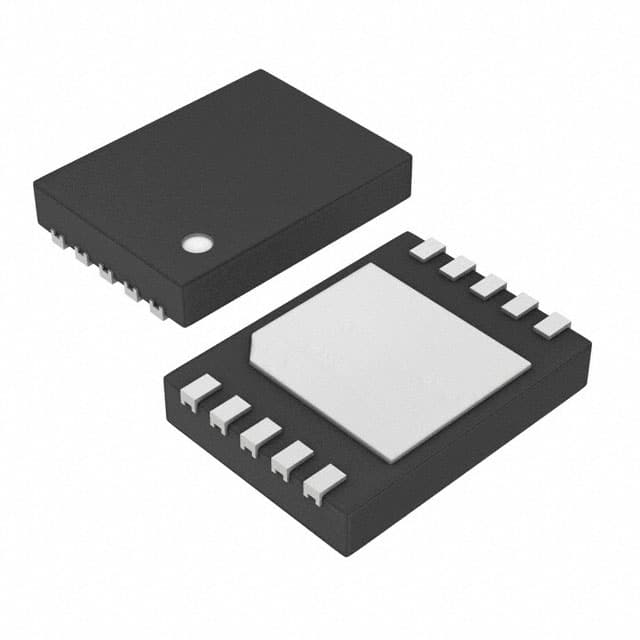MAX17055ETB+T
Product Overview
- Category: Integrated Circuit (IC)
- Use: Battery Fuel Gauge
- Characteristics: Accurate battery state-of-charge estimation, low power consumption, small package size
- Package: 12-pin TDFN (Thin Dual Flat No-Lead) package
- Essence: Monolithic battery fuel gauge system
- Packaging/Quantity: Tape and reel packaging, 3,000 units per reel
Specifications
- Operating Voltage Range: 1.7V to 3.6V
- Battery Chemistry: Li-ion/Li-Polymer
- Temperature Range: -40°C to +85°C
- Communication Interface: I2C
- Accuracy: ±1% for voltage, ±5% for current, ±7.5% for capacity
- Standby Current: 7µA (typical)
Pin Configuration
The MAX17055ETB+T has a total of 12 pins, each serving a specific function:
- VDD: Power supply input
- GND: Ground reference
- SDA: I2C data line
- SCL: I2C clock line
- ALERT: Interrupt output
- BAT: Battery voltage sense input
- TS: Thermistor input for temperature sensing
- STAT: Status output
- VSS: Negative terminal of the sense resistor
- VDD: Positive terminal of the sense resistor
- VSS: Negative terminal of the sense resistor
- VDD: Positive terminal of the sense resistor
Functional Features
- Accurate battery state-of-charge estimation
- Dynamic compensation for aging batteries
- Low power consumption for extended battery life
- Programmable alert thresholds for various battery conditions
- Temperature compensation for accurate readings in different environments
- Support for multiple battery chemistries
Advantages and Disadvantages
Advantages: - Accurate estimation of battery state-of-charge - Low power consumption prolongs battery life - Small package size allows for space-constrained applications - Wide operating voltage range supports various battery chemistries
Disadvantages: - Limited accuracy for current measurement - Relatively high cost compared to simpler fuel gauge solutions - Requires I2C communication interface for configuration and data retrieval
Working Principles
The MAX17055ETB+T utilizes a sophisticated algorithm to estimate the state-of-charge of a Li-ion/Li-Polymer battery. It measures the battery voltage, current, and temperature to calculate the remaining capacity. The algorithm dynamically compensates for battery aging and adjusts the estimation accordingly. The device communicates with a host microcontroller through the I2C interface, providing real-time battery information.
Detailed Application Field Plans
The MAX17055ETB+T is widely used in portable electronic devices, such as smartphones, tablets, and wearable devices. It is also suitable for applications where accurate battery monitoring is critical, such as medical devices, industrial equipment, and IoT devices. The small package size and low power consumption make it ideal for space-constrained and battery-powered applications.
Alternative Models
- MAX17055G+T: Similar specifications and features, but with a different package (16-pin TQFN)
- MAX17055H+T: Higher accuracy and extended temperature range, suitable for demanding applications
- MAX17055F+T: Lower cost variant with reduced accuracy and limited features, suitable for budget-conscious designs
These alternative models provide options based on specific requirements and constraints, allowing designers to choose the most suitable solution for their application.
Word count: 439 words
قم بإدراج 10 أسئلة وإجابات شائعة تتعلق بتطبيق MAX17055ETB+T في الحلول التقنية
Sure! Here are 10 common questions and answers related to the application of MAX17055ETB+T in technical solutions:
Q: What is the MAX17055ETB+T? A: The MAX17055ETB+T is a fuel gauge IC (Integrated Circuit) designed for accurately measuring the remaining capacity of a battery.
Q: What type of batteries can the MAX17055ETB+T work with? A: The MAX17055ETB+T is compatible with lithium-ion (Li-ion) and lithium polymer (LiPo) batteries.
Q: How does the MAX17055ETB+T measure battery capacity? A: It uses a combination of voltage, current, temperature, and other parameters to estimate the remaining capacity of the battery.
Q: Can the MAX17055ETB+T be used in portable devices? A: Yes, the MAX17055ETB+T is commonly used in portable devices such as smartphones, tablets, and wearables.
Q: Does the MAX17055ETB+T require calibration? A: No, the MAX17055ETB+T is factory-calibrated and does not require additional calibration.
Q: Can the MAX17055ETB+T communicate with a microcontroller? A: Yes, it supports I2C communication, allowing it to interface with microcontrollers and other devices.
Q: What is the accuracy of the MAX17055ETB+T? A: The MAX17055ETB+T has a typical accuracy of ±1% for most applications.
Q: Can the MAX17055ETB+T monitor multiple batteries simultaneously? A: Yes, it can monitor up to two batteries simultaneously using its dual-cell architecture.
Q: Does the MAX17055ETB+T have built-in protection features? A: Yes, it includes overvoltage, undervoltage, and overcurrent protection to safeguard the battery.
Q: Is the MAX17055ETB+T suitable for low-power applications? A: Yes, the MAX17055ETB+T has a low quiescent current and is well-suited for low-power devices.
Please note that these answers are general and may vary depending on specific application requirements.


